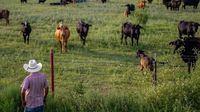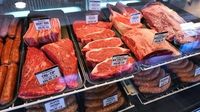Three weeks into a government shutdown, the U.S. cattle industry finds itself at the heart of a heated policy debate, with the Trump administration unveiling a sweeping plan to bolster domestic ranchers even as it moves to dramatically increase beef imports from Argentina. The dual-pronged approach—part protection, part market intervention—has ignited strong reactions from ranchers, economists, politicians, and advocacy groups across the country.
On October 22, 2025, U.S. Secretary of Agriculture Brooke Rollins announced a comprehensive plan aimed at "strengthening" the cattle industry and lowering consumer beef prices. According to the Iowa Capital Dispatch, the plan promises to expedite deregulatory reforms, boost processing capacity, and work across government agencies to remove barriers for ranchers. Rollins declared, "America’s food supply chain is a national security priority for the Trump Administration. We are committed to ensuring the American people have an affordable source of protein and that America’s ranchers have a strong economic environment where they can continue to operate for generations to come."
The plan includes a memorandum of understanding between the USDA and the Department of the Interior, expected in November, to streamline and expand ranchers’ access to federal grazing lands. The initiative prioritizes grazing on nearly 24 million acres of vacant allotments across the country, with the Bureau of Land Management and U.S. Forest Service collaborating to ease permitting. The plan also introduces new standards of evidence for ranchers to be compensated for livestock lost to predators, with the Farm Service Agency’s indemnity programs now covering up to 100% of market value for such losses.
Importantly, the plan seeks to attract new producers to ranching, with the National Institute of Food and Agriculture promoting outreach and education through grant applications. This comes as USDA data reveals a troubling decline in U.S. cattle and cow inventories and a shrinking number of farms—a trend that has many in the industry worried about the future of American beef.
But the most contentious development is President Donald Trump’s proposal to import more beef from Argentina as a way to lower prices for American consumers. The administration confirmed plans to quadruple the tariff-rate quota for Argentine beef imports, a move that has triggered alarm among domestic producers. As reported by The Hill, the National Cattlemen’s Beef Association responded forcefully: "America’s cattlemen and women operate in one of the most competitive marketplaces in the world. U.S. cattle producers are proud to provide the safest, highest-quality beef on earth." The association warned the administration not to "undercut" American ranchers by manipulating prices through increased imports.
President Trump, however, remains steadfast. On October 22, he posted on Truth Social that cattle ranchers "don’t understand" the benefits tariffs have brought to their industry, insisting that they "have to get their prices down" for consumers. According to the U.S. Bureau of Labor Statistics, prices for ground chuck have risen more than a dollar per pound since the start of the year, reaching historic highs. The average price per pound of ground beef hit $6.31 in August 2025—up over 77 cents from January and 74 cents from August 2024.
Ranchers and local leaders have pushed back. Warren Symens, a fourth-generation South Dakota rancher, told Dakota News Now, "He’s completely out of touch with the fundamentals of the buying and selling of cattle in the country. The tariffs have very, very, very little to do with anything going on out in cattle country." South Dakota Governor Rhoden called Trump’s comments and the communication around the beef import plan "unfortunate," noting that it rattled markets and caused unnecessary uncertainty. "I think we’ll get past it. It affected the markets, and that’s the biggest casualty of this kind of communication and the way it was brought across," Rhoden said.
In Texas, the opposition is just as fierce. The Texas and Southwestern Cattle Raisers Association warned that the proposal threatens efforts to stabilize the market through natural herd rebuilding. Darren Hudson, an agricultural economist at Texas Tech, explained to KCBD that ranchers see the reintroduction of Argentine beef imports as competition that could erode price gains achieved since 2025. "So they see that as competition for U.S. beef, and in the immediate since 2025, since President Trump took office, there has been a dramatic reduction in those imports because of tariffs," Hudson said. He added, "That reintroduction of those imports is eroding those price gains that they had."
Hudson also noted that while the impact on steak quality and safety would be minimal due to USDA regulations, the biggest effect would be felt in ground beef, which is the most consumed meat portion in the U.S. "The consumer impact is likely to have the biggest impact there," he said. Ranching groups have urged the administration to let market forces work without interference, emphasizing the importance of supporting domestic producers as the backbone of rural communities.
The USDA’s action plan, announced in tandem with the import proposal, aims to protect domestic beef producers through a range of measures. These include transparent "Product of the USA" labeling, enforcement of fair beef markets, and enhanced local processing. The department will launch another round of funding for the Meat and Poultry Processing Expansion Program to support small processors and intends to reduce regulations that increase their costs. Deregulatory actions by the EPA on Clean Water Act rules are expected to save $1.1 billion to $7.8 billion in future compliance costs for livestock and meat processors, though environmental groups have voiced concerns about potential water contamination.
The plan’s final prong is to boost both domestic and international demand for U.S. beef, aiming to smooth out the boom-and-bust cycles that have plagued the industry. The Food and Nutrition Service has already accepted over $18 million in applications for farm-to-school projects that encourage child nutrition providers to purchase from local ranchers and farmers. Health and Human Services Secretary Robert F. Kennedy Jr. praised the plan, saying it helps restore "whole foods as the foundation of the American diet" and ends the stigma against "natural saturated fat in beef and dairy products."
Meanwhile, the American Farm Bureau Federation remains wary. President Zippy Duvall warned that expanded imports could push farmers deeper into debt and increase reliance on foreign food supplies. "This is a pivotal moment for America’s cattle farmers as they make decisions whether to restock their pastures," Duvall said. "Farmers know America’s families prefer to buy U.S. beef. If expanded imports push farmers deeper into the red, we face the unintended consequence of increasing reliance on other countries for our food and weakening our ability to rebuild a strong American herd."
Amid these debates, the USDA planned to reopen Farm Service Agency offices on October 23, 2025, to release over $3 billion in aid to farmers during harvest season, despite the ongoing government shutdown. Rollins clarified that this aid is separate from a forthcoming package aimed at farmers harmed by Chinese trade disputes, as China has shifted its soybean purchases to Argentina in response to retaliatory tariffs.
As the dust settles, ranchers, policymakers, and consumers alike are left to weigh the balance between affordable food, fair markets, and the future of America’s cattle industry—a future that now depends as much on policy choices in Washington as on the hard work of those out on the range.


